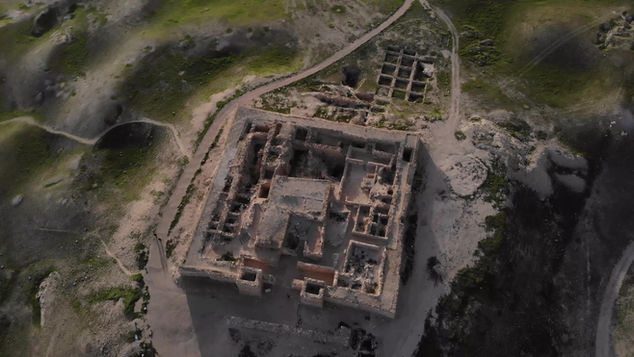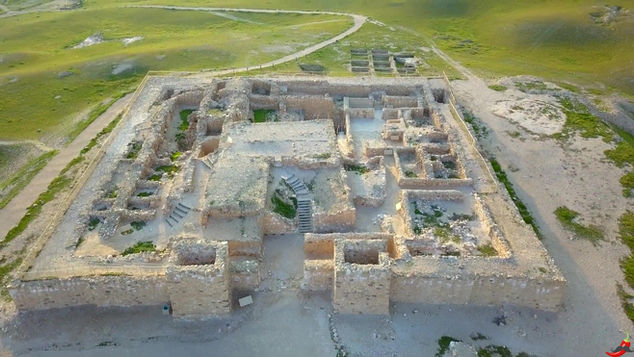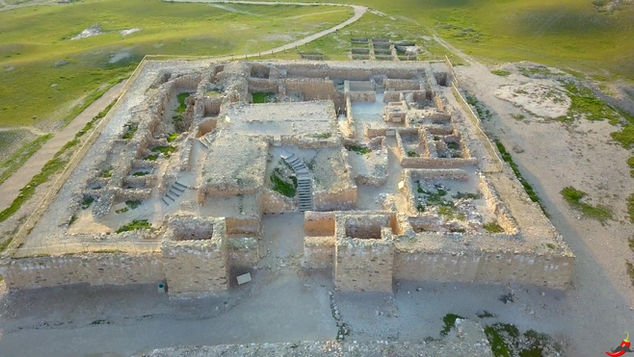

Tel Arad
Photo Gallery
.png)
.png)
Places of Interest
Tel Arad
Location
1. Tel Arad is in the Negev about 16 miles (26 km.) east of Tel Beersheba, and 33 miles (54 km.) south of Jerusalem.
2. Tel Arad covers an area of about 100 acres (40 hectares) and is on the west side of Hwy 80.
3. Although this part of the Negev receives little rain, Arad is strategically situated on ancient trade routes.
Historical Background
1. Tel Arad has two major settlement periods, a Canaanite and an Israelite period. The lower part of the tel is from the Canaanite period and the upper fortress part is from the Israelite period.
2. The Canaanites were the original settlers of Arad and established a large city here around 3500 BC. It had an estimated population of approximately 2,500 residents.
3. Israel captured Arad in the conquest under Joshua. Later, in around 940 BC, an Israelite settlement was established here.
4. Because Tel Arad is so strategically located and important, it was destroyed and rebuilt 6 times from the 9th to the 6th centuries. It was most likely destroyed in 701 BC by the Assyrians and again by the Babylonians in 587 BC.
5. Over 100 pottery shards (Ostraca) were discovered at Tel Arad dating to the 7th and 6th centuries BC. Two of these are of great value as they mention two people from priestly families in the Bible, “Pashhur” from Ezra 2:38, and Meremoth from Ezra 8:33.
6. Two other pottery shards found at Tel Arad have written on them the name Arad, which confirms the identification of the city.
Places of Interest
1. Canaanite City
-
City walls
-
City gate
-
Temple
-
Palace
-
City Well
-
Homes
2. Entrance to Tel Arad
3. Upper parking – Easy access to the Fortress Mound
4. Israelite Fortress at Tel Arad
-
Although there was a small settlement during the time of Solomon, it was during the divided kingdom period that a fortress was set up at Tel Arad. The fortress served to protect Judah’s southern border against its enemies.
-
The southern area of Judah was dangerous, and the fortress at Arad was destroyed 6 times during the divided kingdom period.
-
It is likely that one of the destructions of the fortress occurred during Hezekiah’s reign when he rebelled against the Assyrian King, Sennacherib, in 701 BC. Scripture recounts how all the fortified cities of Judah were destroyed at this time (2 Kings 18:13).
-
The fortress was rebuilt but destroyed again as a result of Nebuchadnezzar’s conquest of Judah in 586 BC.
-
During the Hellenistic period of the 3rd to 2nd centuries BC, a tower was built in the center of the fortress compound. During the Persian, Hellenistic, and Roman periods, the tower was repaired and used as a military post. During the early Arab period, the structure served as an inn for caravans.
-
The fortress was finally abandoned in the 10th century AD.
-
Entrance Towers
-
Outer Court
5. Israelite Temple at Tel Arad
Arad had a functioning temple during the time of the divided kingdom that was somewhat similar to the temple in Jerusalem.
The temple at Arad was forbidden by God because the Israelites were to worship at no other place but Jerusalem at this time (Deut. 12:5-6).
-
Outer Court
-
Altar
-
Holy place – In Scripture, the holy place was a long rectangular room. At Arad, it is a wide rectangular room.
-
Altars of Incense
-
Holy of Holies
-
Dimensions of the Holy of Holies – In the tabernacle God ordered Moses to erect, the required dimensions of the Holy of Holies were to be 10 cubits by 10 cubits (15 ft., 9 m.) (Ex. 26:31–33). In Solomon’s temple, the Holy of Holies measured 20 cubits by 20 cubits (30 ft., 9 m.) (1 Kings 6:16). When the second temple was rebuilt under Ezra, the measurements of the Holy of Holies of Solomon’s temple were kept.
-
The Holy of Holies at Arad measures about 7 ft. by 7 ft. (2.13 m.), much smaller than the Tabernacle of Moses and the First and Second Temples in Jerusalem.
-
Standing stones – There are two standing stones in the Holy of Holies. One represents Yahweh and the other, Asherah, a false female god. This shows the worship of false gods mixed with the worship of God. Clearly, this was strictly forbidden.
-
According to archeological data, the temple in Arad was destroyed during King Josiah’s reign in about 630 BC (2 Kings 23:4–20). It’s possible, though, that the temple could have been removed by King Hezekiah under his reforms (2 Kings 18:22).
-
Even though the worshipers at Arad were commanded to tear down the temple there, they refused to do so and covered it over with dirt instead.
Arad in the Bible
1. The King of Arad attacked Israel while they were making their way toward the Promised Land.
Numbers 21:1–3: When the Canaanite, the king of Arad, who lived in the Negeb, heard that Israel was coming by the way of Atharim, he fought against Israel, and took some of them captive. 2 And Israel vowed a vow to the Lord and said, “If you will indeed give this people into my hand, then I will devote their cities to destruction.” 3 And the Lord heeded the voice of Israel and gave over the Canaanites, and they devoted them and their cities to destruction. So the name of the place was called Hormah.
2. After the confrontation with the king of Arad, the Israelites turned around and headed south toward the Red Sea instead of entering the Promised Land from the Negev region (Num. 21:4).
3. The area of Arad was given to the tribe of Simeon during the conquest of the land (Joshua 19:1–8).
4. The relatives of Moses’ father-in-law (Kenites) also settled in the area around Arad.
Judges 1:16–17: And the descendants of the Kenite, Moses' father-in-law, went up with the people of Judah from the city of palms into the wilderness of Judah, which lies in the Negeb near Arad, and they went and settled with the people. 17 And Judah went with Simeon his brother, and they defeated the Canaanites who inhabited Zephath and devoted it to destruction. So the name of the city was called Hormah.
Josiah’s Reforms and destruction of the temple in Arad.
1. Josiah became king and did what was right in the eyes of the Lord.
2 Kings 22:1–2: Josiah was eight years old when he began to reign, and he reigned thirty-one years in Jerusalem. His mother's name was Jedidah the daughter of Adaiah of Bozkath. 2 And he did what was right in the eyes of the Lord and walked in all the way of David his father, and he did not turn aside to the right or to the left.
2. Josiah’s grandfather, Manasseh, was very wicked until God humbled him, and he repented. His father, Amon, was so wicked that his servants killed him (2 Kings 21).
Josiah’s heritage was wicked and could have given him an excuse to live the same way. However, even at an extremely young age of 8, he loved the Lord and did what was right. Interestingly, the Book of the Law wasn’t found until Josiah was 26 years old (2 Kings 22:3). This meant Josiah did what was right from a young age, even without Scripture to guide him.
3. The Book of the Law (Bible) was found and read to Josiah.
2 Kings 22:8–11: And Hilkiah the high priest said to Shaphan the secretary, “I have found the Book of the Law in the house of the Lord.” And Hilkiah gave the book to Shaphan, and he read it. 9 And Shaphan the secretary came to the king, and reported to the king, “Your servants have emptied out the money that was found in the house and have delivered it into the hand of the workmen who have the oversight of the house of the Lord.” 10 Then Shaphan the secretary told the king, “Hilkiah the priest has given me a book.” And Shaphan read it before the king. 11 When the king heard the words of the Book of the Law, he tore his clothes.
4. Josiah read the Bible to his whole kingdom and made a covenant with them to follow the Lord.
2 Kings 23: 1–3: Then the king sent, and all the elders of Judah and Jerusalem were gathered to him. 2 And the king went up to the house of the Lord, and with him all the men of Judah and all the inhabitants of Jerusalem and the priests and the prophets, all the people, both small and great. And he read in their hearing all the words of the Book of the Covenant that had been found in the house of the Lord. 3 And the king stood by the pillar and made a covenant before the Lord, to walk after the Lord and to keep his commandments and his testimonies and his statutes with all his heart and all his soul, to perform the words of this covenant that were written in this book. And all the people joined in the covenant.
5. Josiah cleansed the temple and ordered that all the altars and shrines to the false gods all throughout the land be destroyed (2 Kings 23:4–20). It was most likely Josiah who ordered the temple removed at Tel Arad.
6. Josiah reinstitutes and celebrates the Passover.
2 Chronicles 35:18: No Passover like it had been kept in Israel since the days of Samuel the prophet. None of the kings of Israel had kept such a Passover as was kept by Josiah, and the priests and the Levites, and all Judah and Israel who were present, and the inhabitants of Jerusalem.
2 Chronicles 35:7: Then Josiah contributed to the lay people, as Passover offerings for all who were present, lambs and young goats from the flock to the number of 30,000, and 3,000 bulls; these were from the king's possessions.
7. There was no king like Josiah, who turned to the Lord with all his heart.
2 Kings 23:25: Before him there was no king like him, who turned to the Lord with all his heart and with all his soul and with all his might, according to all the Law of Moses, nor did any like him arise after him.
8. Unfortunately, Josiah’s two sons who reigned after him did not follow the Lord but acted wickedly (2 Kings 23:31–37).
Faith Lesson from Arad
1. The Israelites in Arad set up their own temple and worshiped God their own way, which was forbidden to do. Do we realize that worshiping the right God in the wrong way is still wrong?
2. Josiah’s heritage was rooted in sin, yet he chose to follow the Lord at a very young age. Do we realize that God can still use us mightily regardless of our past if we turn to Him with all our hearts as Josiah did?
3. Even though Josiah followed God with all his heart, his children chose evil. Each person has a free will to do as they please regardless of the kind of parents they have.
Travel Guide Book
664 Pages
Bible Companion Book
654 Pages
Biblical Sites
Israel Overview Tour of All Biblical Sites
Jerusalem Sites
Jerusalem Model City Tour: Israel Museum
Chapel of the Ascension: Ascension & Return of Christ
Church of the Holy Sepulchre History & Background
Church of the Holy Sepulchre In-depth Tour
Death, Burial, Resurrection of Christ
Gethsemane & Church of All Nations
House of Caiaphas: Peter's Denial of Christ
Jerusalem Archaeological Site & Southern Stairs
Kidron Valley: Judgment of God
Pater Noster Church: Lord's Prayer, Olivet Discourse
Church
Prophecy, Proof the Bible Is True: Mount of Olives
Trial of Jesus: Herod/Pilate's Palace
The Old Testament Feasts & Jesus
Zedekiah's Cave & Solomon's Quarry
Sea of Galilee Sites
Capernaum: Jesus' Ministry Base
Gennesaret, Ginosar: Jesus Boat
Boat Ride: Jesus Walks on Water, Calms the Sea
Mount Arbel: The Great Commission
Sower's Cove: Parables of the Kingdom
Other Sites Around the Sea of Galilee
Northern Israel Sites
Caesarea Maritima: Holy Spirit Given to the Gentiles
Church of the Annunciation & St. Joseph Church
Mount Tabor: Transfiguration of Christ
Other Sites In Northern Israel
Central Israel Sites
Gezer: On Crossroads of the World
Jordan River: Crossing into the Promised Land
Jordan River Baptismal Site of Jesus (Qsar al-Yahud)
Judean Wilderness: Testing of Jesus
Philistine Cities of Ashkelon, Ashdod, Gaza, Ekron, Gath
St. George's Monastery (Wadi Qelt)
Valley of Elah: David & Goliath
Southern Israel Sites
Exodus, Red Sea Crossing, Mt. Sinai
The Philistines & Their City Strongholds
Other Sites In Southern Israel
Other Biblical Sites
Exodus, Red Sea Crossing, Mt. Sinai
Other Biblical Videos
Life & Ministry of Jesus Series
Jewish Holy Days & How Jesus Fulfills Them
Future of Israel: Its Wars, Conflicts, Prophecies
Shroud of Turin (Jesus). Fact or Fiction?
What Are the Differences Between Islam and Christianity?
Who Has the Rights to the Holy Land? Jews or Arabs?
What Is the Reason for the War and Conflicts in Israel and the Middle East?



























